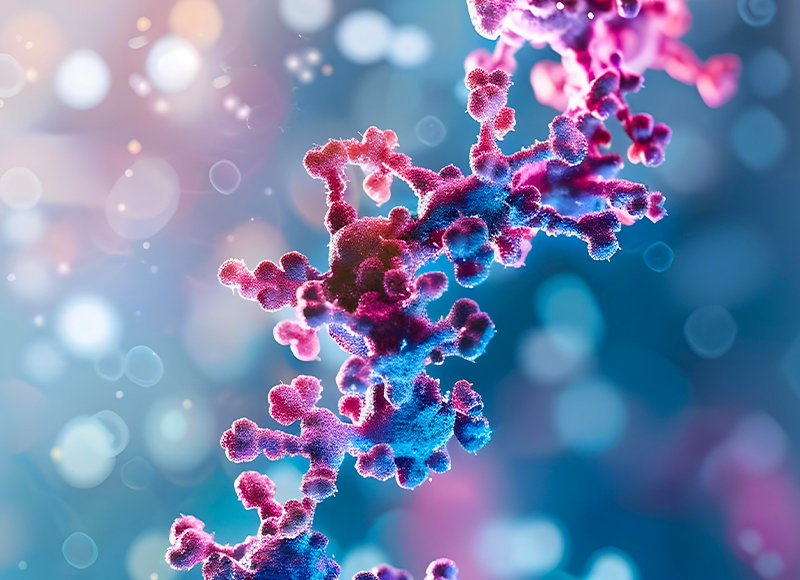16 August 2024
The evolution of recombinant protein production

The evolution of recombinant protein production has been world-changing. Recombinant protein production has significantly transformed the field of biotechnology by enabling the production of complex proteins for therapeutic, industrial, and research purposes.
Since its inception, the technology behind production has evolved dramatically, with new innovative techniques enhancing the quality, efficiency, and scalability of protein production.
Read on to learn more about the evolution of recombinant protein production today, and how our pioneering approach can produce even the most complex proteins with high yields and concentration.
The birth of recombinant DNA technology
Recombinant protein production began in the 1970s with the advent of recombinant DNA technology. This groundbreaking innovation allowed scientists to insert a specific DNA sequence encoding a protein of interest into a host cell, which would then produce the protein through its natural cellular machinery.
The host cell is like a biological factory. It can produce complex proteins that are difficult to obtain through other means. This ability allows for the creation of proteins that are otherwise hard to come by.
Early recombinant DNA experiments were conducted in bacteria, primarily Escherichia coli (E. coli), due to their simple genetics and rapid growth. One of the first major successes was the production of human insulin, which transformed diabetes management by providing a reliable and scalable source of this essential hormone.
This was a significant advancement in pharmaceutical biotechnology, and paved the way for the development of various proteins, and the rise of protein expression systems.
The rise of expression systems
Researchers started looking at different ways to make better proteins as the need for high-quality ones increased. Bacterial systems like E. coli are fast and cheap to use, but struggle to make complex proteins correctly. They have trouble with folding and modifications.
To address these challenges, scientists turned to yeast, insect, and mammalian cell expression systems. Yeast, such as Saccharomyces cerevisiae, provided better protein folding and modification capabilities, making it suitable for producing eukaryotic proteins. Insect cell lines, like the baculovirus expression system, further enhanced protein quality by enabling more intricate modifications.
However, mammalian cell cultures emerged as the gold standard for producing therapeutic proteins, particularly those requiring human-like post-translational modifications. These systems, including Chinese hamster ovary (CHO) cells, offered unparalleled precision in protein folding, glycosylation, and other modifications crucial for therapeutic efficacy.
Introducing bioreactors and industrial fermentation
The transition from laboratory-scale production to industrial-scale manufacturing required advancements in bioreactor design and industrial fermentation processes.
Bioreactors are vessels that provide a controlled environment for cell growth and protein production. They allow precise control over parameters such as temperature, pH, oxygen levels, and nutrient supply, ensuring optimal conditions for high yield and quality.
By integrating bioreactors and industrial fermentation techniques, scientists enabled the large-scale production of recombinant proteins for commercial use. This was instrumental in making therapeutic proteins accessible to patients worldwide, driving advancements in fields such as oncology, hematology, and infectious diseases.
A modern era of recombinant protein production
Recent advancements in genetic engineering have further propelled the evolution of recombinant protein production. Techniques like CRISPR-Cas9 and synthetic biology have revolutionized the ability to design and optimize DNA sequences for enhanced protein expression and functionality.
Now, researchers can precisely engineer host cells to produce proteins of interest with improved yields, stability, and activity.
Moreover, protein engineering approaches, such as directed evolution and rational design, enable the creation of tailored proteins with desired properties. These techniques have opened new avenues for developing therapeutic proteins with increased efficacy and reduced side effects, offering promising solutions for previously untreatable conditions.
Looking for more? Read about custom recombinant proteins and how they’re developed
Turning to natural bioreactors
At Cocoon Bioscience, we are pioneering a new era of recombinant protein production by harnessing the power of cocoons as natural bioreactors. Our innovative approach leverages the unique properties of cocoons, providing a sustainable and efficient solution for biotechnology and life science industries.
Cocoons offer several advantages as natural bioreactors.
- Firstly, cocoons provide a natural environment for protein expression, allowing for efficient production and extraction of high-quality proteins. The silk fibers support cell growth and protein production without the need for complex and costly infrastructure.
- Secondly, our cocoon-based platform is highly scalable, allowing for the production of a large volume, and a wide range of proteins. The system can be easily adapted to meet the specific needs of different projects and applications.
- Finally, our approach is both cost-effective and sustainable. By using natural materials and minimizing the need for synthetic resources, our approach reduces production costs and environmental impact. This aligns with our commitment to sustainable practices in biotechnology
We’re embracing the future of biotechnology
The evolution of recombinant protein production has transformed biotechnology. Over time, unprecedented opportunities have arisen to address complex medical challenges and drive scientific discovery. From its early days of recombinant DNA technology to the modern era of genetic engineering and protein optimization, the field continues to push boundaries and redefine possibilities.
At Cocoon, we are committed to harnessing the power of cocoons as natural bioreactors. In doing so, we empower researchers, clinicians, and industries to unlock the full potential of biotechnology. Using our platform, we deliver high-quality proteins with unparalleled efficiency and affordability. We are paving the way for a new era of innovation in recombinant protein production.
To learn more about our groundbreaking solutions visit our solutions page and discover how our expertise can elevate your projects.


